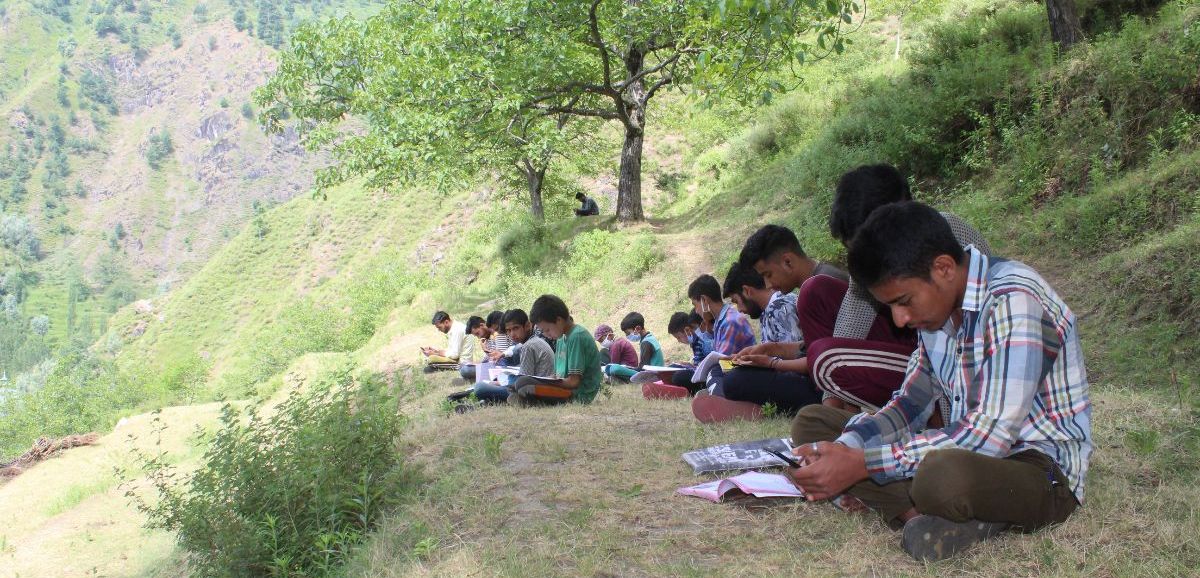A new survey has vindicated the naysayers that children’s overexposure to cell phones and computers for education and recreation is seriously compromising the capacities of Kashmir’s new generation, Khalid Bashir Gura reports
The increased screen time has impacted both the physical and the mental health of the children, according to a basic survey carried out by GMC doctors.
With Covid-19 dominating the entire attention, the society has been oblivious to another pandemic creeping up silently – the scourge of digital dependency. The digital addiction compounded by social media holds people irrespective of age and even toddlers in thrall and afflicts adolescents and adults alike. People irrespective of age are becoming prisoners of their screens. The digital overexposure was necessitated and compounded by the lifestyle dictated by the pandemic.
A paper, Increase in screen-time for children during COVID times and its effects authored by S Muhammad Salim Khan, Sabira Aalia Dkhar, Ruqia Quansar, and Inaamul Haq, in a cross-sectional study revealed that predisposition to digital screens has increased leading to many complications in mental, physical, social spheres of health
The increased screen-time with increased age of the child could be attributed to the fact that the ability or skill to use mobile or any other device increases with age group and thus chances of more frequency and duration of device use.
As schools were shut down during the pandemic and children were holed up inside homes, the study demonstrated that there was an increasing dependency on the digital medium for both education and recreation. Excess screen time does not openly hamper learning capabilities but can lead to adiposity, attention deficiency, and extreme mood alterations in children, which in turn disrupt learning capabilities, the paper revealed. “There are growing apprehensions that this exposure to electronics could have negative effects on the growth and development of children,” it reads.

Some of the statistical findings of the paper have been staggering. “64.5 per cent of parents reported that they do not prefer online applications for the education of the children, whereas 20.2 per cent of parents said that they prefer online applications and 15.3 per cent of parents were not sure about the usage of online educational applications,” the paper reads.
About 61.6 per cent of parents felt that the increased screen time among the children leads to decreased academic achievements, whereas 18.5 per cent of parents did not feel that screen time is associated with academic achievements and 19.9 per cent of parents were not sure about the same.
The usage of smart devices and phones in children may lead to less concentration on other things and thus more dependencies on online gaming.
Approximately 94.5 per cent of parents were in agreement with the fact that the increased screen-time or increased use of smartphones was affecting the physical health of the children, whereas only 5.5 per cent disagreed.
“The use of smart devices/phones leads to more often sedentary behaviour, less exercising, less physical activity, and thus increased obesity and adiposity in the longer run. Less physical fitness as more urge to spend time with their personal device disrupted sleep schedule and strain due to screen light all affect the physical health,” the paper reads.
The increased screen time leads to digital strain on the eyes, headaches, and sleep deprivation and thus affecting physical health. Around 94.1% of parents were in agreement with the fact that the increased screen-time or increased use of devices/phones was affecting the mental wellbeing of the children, whereas only 5.9 per cent were in disagreement.
The research has delved into the fact that the use of smart devices/phones leads to poor concentration and emotional and mood instability and poor self-control. The user may also be associated with anxiety and depression and poor interpersonal relationships.
The maximum number of children belonged to the age group of 6-10 years and most were males (56.1 per cent). Phone (68.7perent) was the most commonly used device.
“The present scenario in wake of Covid-19 has brought to the forefront the need to revisit the concept of screen time from a health perspective. This is important given the exclusive reliance on time spent looking at the screen as a measure to ensure healthy use of the Internet and Internet-enabled devices,” the researchers concluded.

As the research was aimed at children, it, however, does not reveal, the Fear of Missing Out (FOMO) and Joy of Missing Out (JOMO) and how can digital addicts detox themselves. Given the alarming assertions through various studies that digital overuse may be made more alluring by artificial intelligence and can alter the brain itself; there is a question that needs an answer: do we need to go for a digital fast to save the soul? Has it become an unavoidable poisoned chalice?
The American Academy of Pediatrics recommends zero digital media exposure for children under 18 months and only an hour for children aged two to five. The doctors who were part of the study said two hours of exposure to screen is all right but anything beyond that is harmful. The study that GMC doctors carried out was a smaller one and had only 300 plus respondents. However, it overwhelmingly exhibited the trend that evolved in the last few years.















